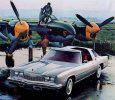Johnson, during 1933—a year prior to the initiation of the Model 10 tunnel tests—had applied to Lockheed for an engineering job. He had not been turned down, but instead had concurred when von Hake recommended that he first return to Michigan and complete his master of science degree in aeronautical engineering. Von Hake also told Johnson that though Lockheed still was in the throes of its post-bankruptcy start-up, there might be an open engineering position if and when forthcoming aircraft programs began to gather momentum. Johnson took von Hake at his word; shortly after the conclusion of Stalker's Model 10 tunnel study, he returned to Lockheed's Burbank, California offices... master's degree in hand...and again asked for employment. Cyril Chappellet (one of the major shareholders in the new company) and Hibbard were the people who actually hired Johnson—as Lockheed's 36th employee. It would be looked back upon as perhaps the single most important personnel transaction in the aircraft manufacturer's history. "Kelly's" debut shortly after his arrival was anything but auspicious. In a meeting with Chappellet and Hibbard during the course of one of his first days at work, he told the engineering group their new Model 10 was only marginally stable. Bluntly, he told the group he did not agree with Prof. Stalker's conclusions. He felt a better and safer aircraft could be designed. These comments came as somewhat of a shock to Hibbard. A day after listening to Johnson's matter-of-fact declaration, he cornered the neophyte engineer and orally reviewed his academic credentials in a face-toface confrontation. He felt certain he could repudiate the Model 10 disparities that had been brought to light. Hibbard would recall, years later, he came close to firing Johnson on the spot. Several months after the encounter, and after concluding Johnson's claims might have some merit, he told the young engineer to return to Michigan and solve the Model 10's stability shortcomings. Johnson drove to Michigan with the large Model 10 wind tunnel model awkwardly squeezed into the back passenger compartment of his car. Some 73 tunnel runs followed, this number being necessary to narrow the sources of difficulty. The idea of attaching "controllable plates" to the horizontal tail tips surfaced while run number 72 was underway. These auxiliary surfaces, tested during run number 73, "worked very well", particularly after the destabilizng wing root fillets were removed. The next step improved control even further. Full, twin vertical tail surfaces now replaced the "plates", supplementing the original fuselage-mounted vertical tail. Superb directional control resulted. It was concluded later the original vertical tail was unnecessary...and it was removed. Johnson, who until the Model 10 assignment had been working as a tool designer at Lockheed, returned from Michigan somewhat a hero and most importantly a "full-fledged member of the engineering staff". In solving the Model 10's problems, he had set the company and its product line on the path to financial success. The Model 10 would give birth to several perturbations including the Model 12 (a scaled-down Model 10) and the highly successful Model 14. Consequently Johnson would be partially responsible for the financial latitude implied in the prototyping of the Model 22...which later would become worldrenowned as the P-38 Lightning. Even in consideration of the several shortterm successes realized during the period from 1934 to 1937, Lockheed's future, by 1938, again had begun to look bleak. Placing most of its eggs in a single basket, a concerted effort under the aegis of corporate representative Kenneth Smith resulted, on June 23, 1938, in the consummation of a contract for between 200 and 250 Model B14L (bomber version of the Model 14) Hudsons for the British Royal Air Force.
